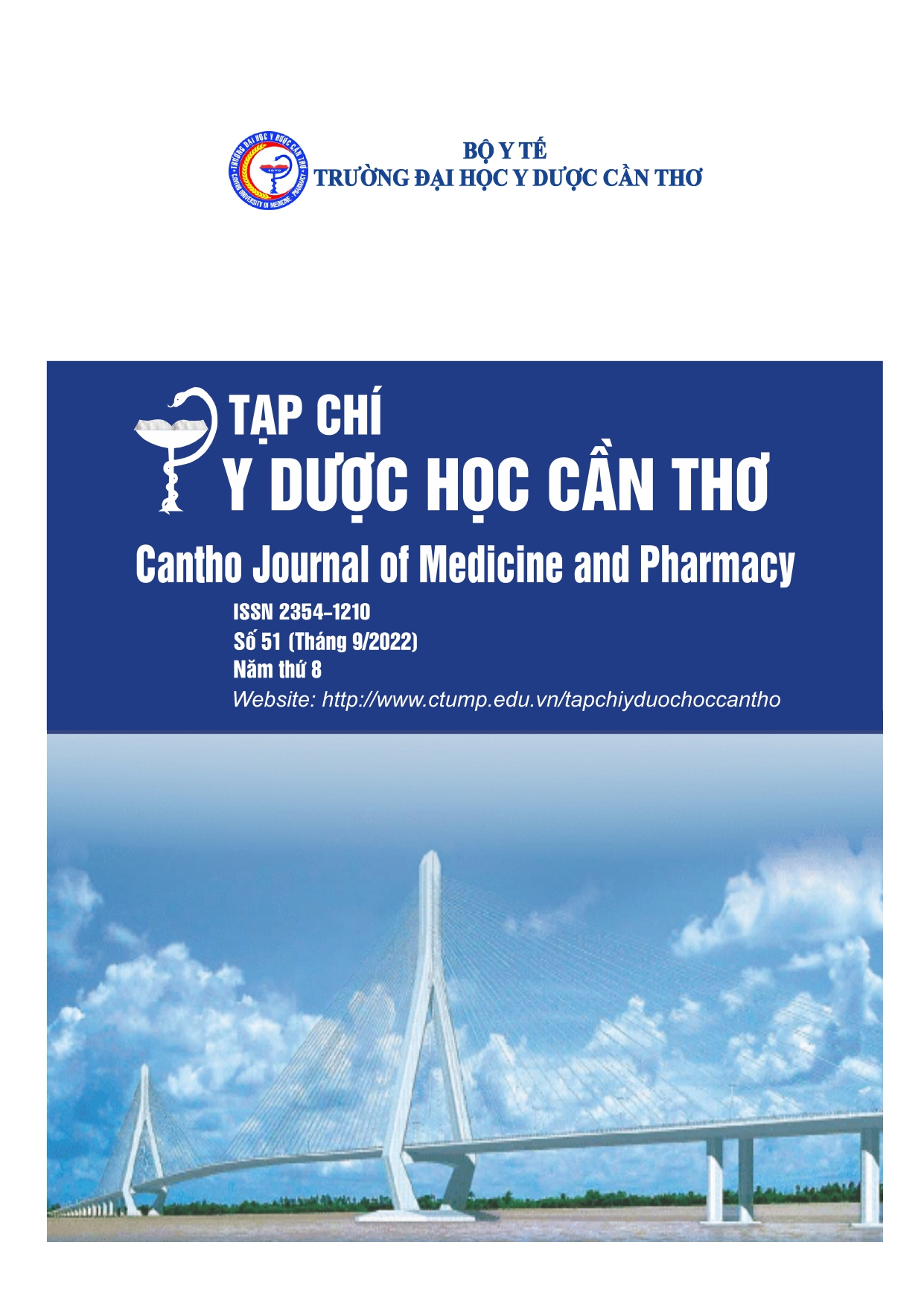RESULT OF CEMENT VERTEBROPLASTY IN OSTEOPOROTIC COMPRESSION FRACTURE IN CAN THO CENTRAL GENERAL HOSPITAL IN 2021-2022
Main Article Content
Abstract
Background: Osteoporotic compressive fracture of the vertebral spine is one of the most common causes of low back pain in the elderly. Vertebroplasty was considered the standard treatment for this condition. Objectives: To evaluate the clinical features, radiology and describe the results of vertebroplasty in an osteoporotic compressive fracture in Can Tho from 2021 to 2022. Materials and methods: Descriptive study of 35 patients with compressive fracture of osteoporosis vertebral spine who underwent surgery by vertebroplasty cement at Can Tho Central General Hospital. Evaluating the results of surgical treatment 24 hours after the operation and three months according to the Visual Analog Scale (VAS score) and Macnab were included and analyzed. Results: Mean age of the patient was 69.91±10.70 years. The Female/ male ratio was 6/1. Classification of vertebral fractures by the Genant (Grade 1: 65.26%, Grade 2: 28.06%, Grade 3: 6.68%). Release of low back pain 24 hours after the operation (VAS): 3.97±0.71 points. The result of surgical treatment after 3 months: excellent 71%, good 26%, 3% fair, and no poor case was reported. Conclusion: This study showed that osteoporotic compressive fracture of the vertebral spine was prevalent in the elderly. Release of lumbar pain at 3 months after (according to the VAS scale) was more than that at the time 24 hours after the operation.
Article Details
Keywords
Osteoporosis, VAS scale (Visual Analogue Scale), vertebroplasty cement, classification of vertebral fractures by the Genant
References
2. Nguyễn Văn Sơn, Vi Trường Sơn (2013), “Kết quả bước đầu điều trị xẹp đốt sống do loãng xương bằng bơm xi măng sinh học tại khoa Ngoại thần kinh-Lồng ngực Bệnh viện Đa khoa tỉnh Phú Thọ”, Y học thực hành, số 1, tr.134-136.
3. Phạm Minh Thông, Phạm Mạnh Cường (2008), “Đánh giá hiệu quả của phương pháp tạo hình đốt sống qua da trong điều trị xẹp đốt sống bệnh lý”, Kỷ yếu các công trình nghiên cứu khoa học Bệnh viện Bạch Mai, 1, tr.62-68.
4. Khúc Văn Trung, Nguyễn Vũ Hoàng (2018), “Kết quả điều trị xẹp thân đốt sống trên bệnh nhân loãng xương bằng phương pháp bơm cement sinh học qua da tại Bệnh viện Trung ương Thái Nguyên”, Luận văn thạc sĩ, Trường Đại học Thái Nguyên, Thái Nguyên.
5. Breivik Harald, PC Borchgrevink, SM Allen, et al. (2008), Assessment of pain. British Journal of Anaesthesia, 101(1), pp.17-24.
6. Genant Harry K, Chun Y Wu, Cornelis van Kuijk, et al. (1993), “Vertebral fracture assessment using a semiquantitative technique”, Journal of bone and mineral research, 8(9), pp.1137-1148.
7. Ho-Pham LT, Nguyen TV (2017), “The Vietnam Osteoporosis Study: Rationale and design”, Osteoporos Sarcopenia, Vol. 3(2), pp. 90-97.
8. Jinjin Zhu, et al. (2020), “Bioactive poly (methyl methacrylate) bone cement for the treatment of osteoporotic vertebral compression fractures”, Theranostics 2020, Vol. 10, Issue 14.
9. K.-S. Tsai, et al. (1996), “Prevalence of Vertebral Fractures in Chinese Men and Women in Urban Taiwanese Communities”, Calcif Tissue Int, 59(4), pp.249-253.
10. Limin Tian, et al. (2017), “Prevalence of osteoporosis and related lifestyle and metabolic factors of postmenopausal women and elderly men A cross-sectional study in Gansu province, Northwestern of China”, Medicine, Vol. 96:43.
11. Mathis, J.M, et al. (2001), “Percutaneous vertebroplasty: a developing standard of care for vertebral compression fractures”, American journal of neuroradiology. 22(2), pp. 373-381.
12. McGirt Matthew J, Scott L Parker, Jean-Paul Wolinsky, et al. (2009), “Vertebroplasty and kyphoplasty for the treatment of vertebral compression fractures: an evidenced-based review of the literature”, The Spine Journal, 9 (6), pp. 501-508.
13. Mori, S., et al. (1993), Factors affecting peak bone mass in Japanese female. In 4th International Symposium on Osteoporosis (Proceedings).
14. Voormolen MH, Mali WP, et al. (2007), “Percutaneous vertebroplasty compared with optimal pain medication treatment: short-term clinical outcome of patients with subacute or chronic painful osteoporotic vertebral compression fractures”, AJNR Am J Neuroradiol, 28, pp. 555-60.


